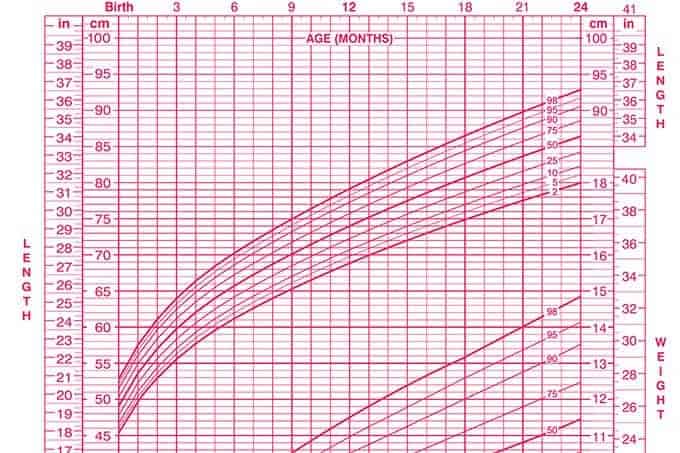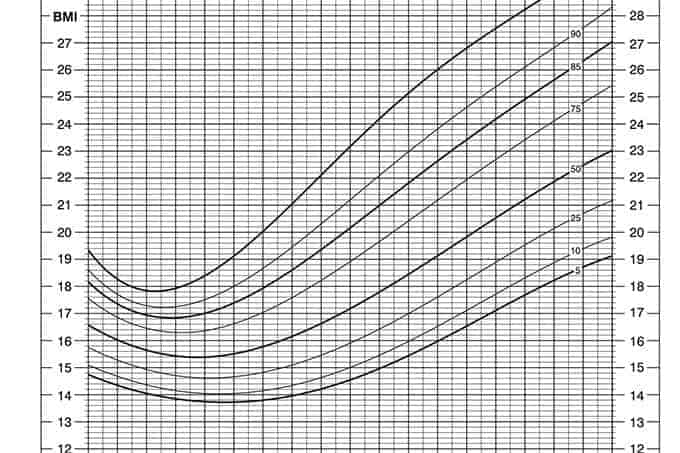Whether you have a kiddo in a high weight percentile, barely on the chart, or somewhere in between, you may have had at least one check up that was stressful. To help, we’ll cover what growth chart percentiles really mean—and what they don’t.
 Growth Chart Percentiles
Growth Chart Percentiles
From the CDC: “Growth charts consist of a series of percentile curves that illustrate the distribution of selected body measurements in children.” At each check up we have for our babies, and then for our kids as they continue to grow, we’ll be told where they are on the growth chart—but it’s all too easy to worry that a child in the, say, 24% is too small, and one in the 98% is too big.
Every time you take your kiddo to the pediatrician for a well check up (and sometimes even at sick visits), their height and weight will be plotted onto the chart so they can keep track of growth.
Table of Contents
- Growth Chart Percentiles
- CDC Growth Chart for Girls and Boys
- How is a growth chart percentile calculated?
- What is a normal growth chart percentile?
- What can growth charts tell us about our kid's health?
- What are they not great at telling us about our kid's health?
- How does BMI play into this?
- What's the difference between WHO and CDC growth charts?
- What should I do if our doctor is concerned about my child's growth chart percentiles?
Your toddler won’t eat? Help is here!
Sign up for our email updates to get tips and ideas sent to your inbox.
CDC Growth Chart for Girls and Boys
If you want to look at the base charts for girls and boys, whether babies or toddlers, here are a few links to pdfs if they help you.
- CDC’s growth chart for girls baby to 24 months.
- CDC growth chart for girls aged 2-20.
- CDC’s growth chart for boys baby to 24 months.
- CDC growth chart for boys aged 2-20.
How is a growth chart percentile calculated?
At a check up, the clinician will measure height, weight, and head circumference. That data will be plotted on the growth chart and compared to the normal range and to the child’s own previous curve. This is what you will typically be shown on a computer in the exam room.
What is a normal growth chart percentile?
Here’s a great explanation of “normal” from UPMC (emphasis is theirs):
It’s important to note that there is a wide range of what is considered normal. In fact any infant percentile can be considered normal, as long as a child continues to follow that growth percentile or above. If a child’s growth follows the curve of the chart, it indicates that they are getting the correct nutrition and their growth is progressing as expected.
If a child continues to drop in percentile on their child growth chart, this could be cause for concern. Dropping may indicate that they are not getting adequate nutrition or that further testing should be done to evaluate what may be impacting their growth.
TIP: That means that a child at 99% on the chart can be NORMAL. And a child at 2% on the chart can be NORMAL. And anywhere in between. It’s more about whether the child is on their own growth curve or if they’ve spiked up or down.
What can growth charts tell us about our kid’s health?
Charts can be helpful in highlighting potential issues to keep an eye on. If a child continues to drop in percentile on their own growth curve, that could be a cause for concern. If a child spikes up, that too could be cause for concern. (It may not be an immediate concern though, because kids don’t always grow exactly on their curve.)
If either happens to you, be sure to ask questions, ask for a lot of clarification on any advice (because appointments are short and you may need to push to get a full explanation), request additional testing or information to be gathered—the chart alone may not be the best diagnostic tool.
You can also ask something as simple as, “Can we keep an eye on this at our next check up?” in response to any advice about a child “needing” to gain or lose weight. The response may tell you a lot about whether the concern is urgent or can simply be monitored over a longer span of time.
TIP: As the CDC says in their own words, “Growth charts are not intended to be used as a sole diagnostic instrument. Instead, growth charts are tools that contribute to forming an overall clinical impression for the child being measured.”
What are they not great at telling us about our kid’s health?
Growth chart percentiles tell us nothing about a child’s body mass or lifestyle. They don’t share how active or sedentary a child may be, what he eats, drinks, or likes to do. They don’t tell us anything about mental health, living circumstances, anxiety, happiness, or…anything else that impacts a child’s life.
They are a snapshot of three specific growth measurements and provide an incomplete picture of total health.
 How does BMI play into this?
How does BMI play into this?
To calculate BMI, you’d take a child’s age, height, and weight and plug it into this calculator. The result will tell you whether a child is underweight, a healthy weight, overweight, or obese.
BMI-for-age percentile shows how your child’s weight compares to that of other children of the same age and sex. For example, a BMI-for-age percentile of 65 means that the child’s weight is greater than that of 65% of other children of the same age and sex.
It’s worth noting that these BMI percentiles express a child’s BMI relative to US kids who participated in national surveys conducted from 1963-65 and 1988-94. That means kids today are not being compared with their peers, which are currently more diverse in ethnicity and yes, larger in size than two decades ago.
But again, REMEMBER that these figures don’t take the full picture into consideration. BMI doesn’t reflect a child’s body mass, nor does it consider lifestyle. Here, again, the CDC says that, “Please keep in mind that this BMI calculator is not meant to serve as a source of clinical guidance and is not intended to be a substitute for professional medical advice.”
The classifications on the BMI chart were also changed one day in the 90s, so suddenly a whole swath of people were suddenly considered “obese” that weren’t the day before. I highly recommend reading What We Don’t Talk About When We Talk About Fat for more of this context and how it relates to the focus on weight loss in healthcare, marketing, and nutrition education.
What’s the difference between WHO and CDC growth charts?
And if you thought this wasn’t already complicated enough, the World Health Organization AND the CDC both have their own growth charts. The CDC actually recommends that clinicians use the WHO one for babies up to 24 months because the CDC growth charts are references and they identify how typical children in the US did grow during a specific time period. But remember: These “typical growth patterns” may not be ideal growth patterns for any given child.
The WHO growth charts, on the other hand, sets a standard and identifies how children should grow when provided “optimal conditions.” (I have yet to be able to find an explanation of exactly that that means so take it with a grain of salt!)
What should I do if our doctor is concerned about my child’s growth chart percentiles?
First, know that you don’t have to solve it or have a plan in place right at that very second. It’s okay to digest their concerns, and then ask questions—even if you need to call back a few days later or email them after you get home. You can ask for additional testing. Ask what will happen if you don’t do what they suggest. Ask for another consultation with a second doctor to see if they agree.
Just because a child is low on the growth curve does not mean that they need “fattening up”. If a health care provider says that a child needs to gain weight, probe deeper. Ask if you can check in at the next appointment. Ask what will happen if you don’t do what they recommend.
Because remember: It is really hard to force a child to eat more food than they are hungry for and that is an aspect that often gets lost in those (of course well-meaning) doctor’s office conversations.
Focus on mental health, food security and access, movement, and eating together as a family. Review the basics of the feeding approach known as the Division of Responsibility.
Body size is never a problem that we need to fix, but we can impact overall health by looking at the overall lifestyle of the whole family.
TIP: Read more about why Kids Don’t Need to Diet here.
Related Posts
I’d love to hear your experience with this topic or any lingering questions you may have, so please comment below to share!
This post was first published on August 22, 2019.























Hi there, Thank you so much for sharing this information with us. It really helps us. As parents we should take care of our kid’s health. I really appreciate your content.
Hey guys-me (Sarah-Ann) again,
Virginia referenced some studies where the BMI/mortality association was inconclusive. Can you link them? I would like to use them in a presentation I give about reframing the weight convo. Thanks!
Sarah
I’ll email you some!